Head lice, the scourge of day care centers and elementary schools, might have just become a bigger problem. A new strain of “super lice” has infested people in 25 states, potentially making it more difficult to get rid of the parasites. The Centers for Disease Control and Prevention reports there are up to 12 million cases of lice a year, mostly among children. But itching doesn’t necessarily mean an active infestation, and neither does the sight of eggs. But if creepy crawlers are found, over-the-counter and prescription products can treat the social malady, said Dr. Bernard “Buddy” Cohen, a pediatric dermatologist at the Johns Hopkins Children’s Center.
How are super lice different from the usual bugs?
The “new” lice tend to have mutations that increase resistance to the over-the-counter pediculocides.
How common is this new strain in children compared with the regular kind?
They are actually pretty common and may account for the majority of head lice around the country. It is still unclear if this makes a difference in terms of clinical response to treatment with these agents, so I still recommend a trial with over-the-counter products. If (there are) problems with response, and we are sure that the kids and families have been treated properly, I would consider using the newer (U.S. Food and Drug Administration) approved agents.
I’ve heard that schools send home kids who are scratching, but does that necessarily mean lice? How is it diagnosed?




